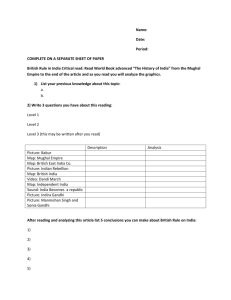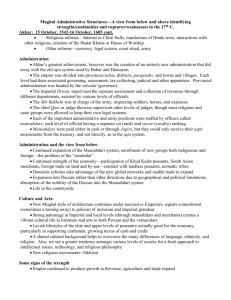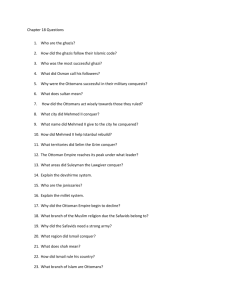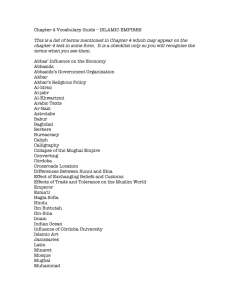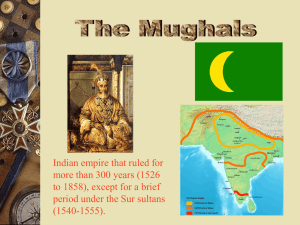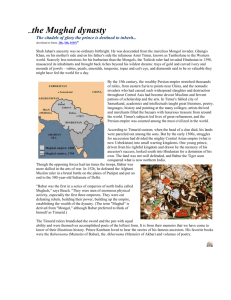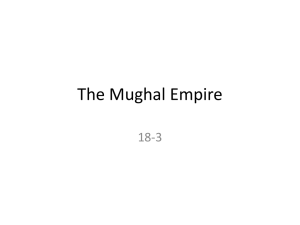The Mughal Empire
advertisement
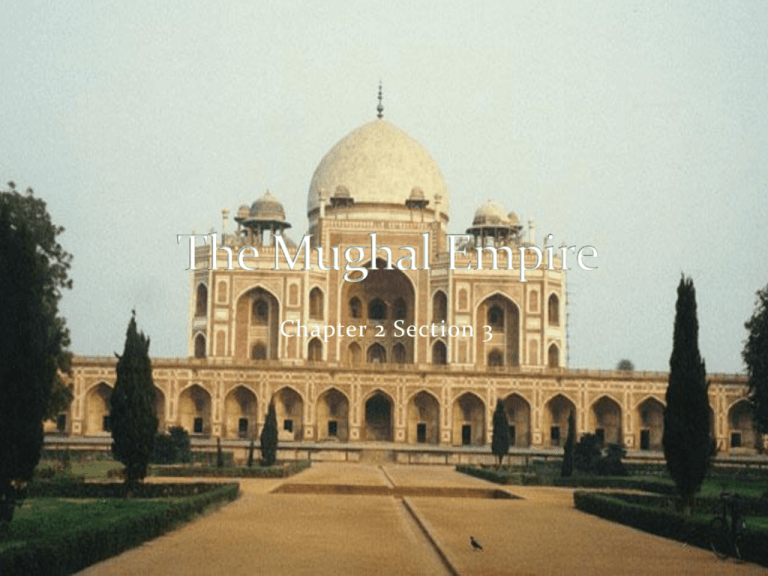
Chapter 2 Section 3 UEQ: How was absolutism expressed in different areas around the world? LEQ: How did Akbar use cultural blending in the Mughal Empire? Mughal Akbar Babur Taj Mahal Shah Jahan Mumtaz Mahal Sikh Sultan Aurangzeb Using the same map that you have filled in when we talked about the Ottoman and Safavid Empires, turn to page 71 in your textbook. Use the map that you filled for the Ottoman and Safavid Empires and fill in the Mughal Empire using a different colored pencil. Be sure to label that new empire in the map legend. Mughals began as a group of Muslims that took over parts of the country of India. These controlling Muslims were given the nickname of Mughal, which means “Mongol.” Are they the same??? For 300 years, Hindus and Muslims fought over the land of the country of India. 1494 11 year old boy by the name of Babur, inherits land in an area to the north of India. Other rulers kick him out of the small empire and force him to move south. Babur builds an army and takes over much of the country of India. Babur was a brilliant military leader. Defeated an army of 100,000 soldiers using his own army of 12,000. After Babur’s death, his 13 year old grandson Akbar becomes ruler of the Mughal Empire in India. As ruler Akbar realized that he could increase his power by creating a large army. Akbar was able to gain control of land in India that his grandfather, Babur could not. Akbar helped unite 100 million people within the Mughal Empire. Under Akbar, a golden age “age of wealth” begins in the Mughal Empire. Cultural Blending Like the Safavid ruler Suleiman , Akbar allowed religious freedom in India. He married Hindu princesses without forcing them to change their religion. He got rid of the tax on non-Muslims and the tax that travelers paid to come into the country. Allowed Hindus and Muslims to work together in government jobs. Cultural Blending allowed Akbar to change different areas in the Mughal Empire. Art Book Illustrations “miniature scenes” became very popular in the Mughal Empire and other countries. Architecture Mughal buildings used Hindu building designs Literature Mughal stories became very popular and books on the events were demanded by other ethnic groups. 1605 Akbar dies and the Mughal government changes to allow itself to handle new situations better and faster. 2 New Rulers Jahangir Allowed his wife Nur Jahan to rule instead of him, her rule causes religious problems and fights between Mughals and the Sikhs, which were a non-violent religious group. Shah Jahan Son of Jahangir Did not tolerate competition to be ruler, so he had all of his rivals assassinated. Two Passions Beautiful Buildings His wife Mumtaz Mahal 1631 Mumtaz Mahal dies at the age of 39 while giving birth to her 14th child. To “remember” his wife, Shah Jahan has the Taj Mahal built with the order that it be built, “as beautiful as she was beautiful.” Taj Mahal Today While Shah Jahan had gardens, monuments, and forts built for the country, he used very little money to help the Mughal people. Problems Shah Jahan increased taxes regularly to pay for his expensive projects. 1657 Shah Jahan becomes ill and his four sons fight for control and power. Aurangzeb, Shah Jahan’s third son takes over, has his oldest brother killed and his dying father imprisoned. Aurangzeb rules from 1658 to 1707 Expanded land controlled by the Mughal Empire Problems Outlawed most activities (drinking, gambling, etc.) Forced people to pray at certain times during the day by having police watch people. Brought back taxes on non-Muslims and visitors to the country. Kicked Hindus out of government jobs. Had many Hindu buildings and monuments destroyed. Because of the high taxes, Aurangzeb forced Mughals’ into poverty, which caused Aurangzeb to not be able to pay to rebuild the Mughal army. 2 million Mughals’ died because of famine and disease spreading in India. Aurangzeb gave cities and land to different European ethnic groups, such as the Dutch, French, and English. Allows European countries to control India years later. When Aurangzeb dies, his three sons fight for control of the Empire, which is just small pieces of land. Complete the handout on the most important women in the history of India. Using page 85 in your textbook, read the chart at the top of the page to help you answer the same three questions for each of the four women. Write your answers in the chart on the back. Use the charts information to help you answer the four questions at the bottom of the page. Be sure to answer the questions in full detail. Below are the names of the rulers that were the most important to the Mughal Empire, for each one give a brief explanation how each had a positive (good) or negative (bad) effect on the Mughal Empire. Shah Jahan Aurangzeb Babur Akbar Jahangir

